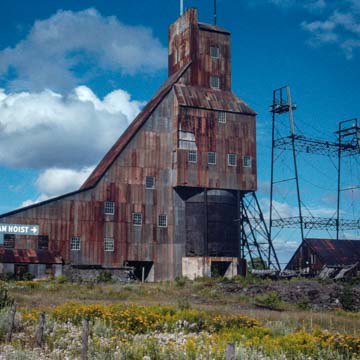You are here
Quincy Unit, Keweenaw National Historical Park (Quincy Mining Company)
Located on Quincy Hill and known as “Old Reliable” for the long series of dividend payments to stockholders, the Quincy Mining Company began when investors from Detroit and Marshall, Michigan, established the company in 1846; they incorporated and purchased land here in 1848. Shortly before, in 1845, the Pittsburgh and Boston Mining Company opened the Cliff Mine at the northern tip of fissure veins in the Copper Range, where pure native copper appeared in large masses; in 1847 the Minnesota Mining Company opened a mine at the southwestern tip, near Rockland. The Quincy Mining Company explored the land for copper and, at the same time, reorganized because of the need for capital and management. It moved its offices first to Philadelphia, and then in 1858 to New York City, since its primary investors resided there and in Boston. In 1854 Columbus Christopher Douglass discovered the first extensive vein of amygdaloid copper, or the Quincy Lode, and in 1855 he sank two shafts. In the 1860s the Quincy ranked first nationally in copper production, and 3,000 people lived and worked on the hill at the Quincy, Pewabic, and Franklin mine locations. Eventually, though, the production of the Calumet and Hecla Mining Company superseded the Quincy's production.
The Quincy Mining Company succeeded and grew because it took advantage of technological advances, acquired land to permit the tapping of the Pewabic Lode, and in general because of good management and well-trained workers. By 1905 the Quincy employed 1,850 people in Michigan. On the hill, the company built a machine shop, a roundhouse, a boiler house, a blacksmith shop, a warehouse, dry houses, carpenter shops, kiln houses, shaft and rock sorting houses, powder magazines, and other surface structures. For its workers, the company built boardinghouses, single-family dwellings, tenement houses, a hospital, and bathhouses. Workers lived in residential enclaves, which were clustered at shafts, known as locations, called Limerick, Swedetown, Frenchtown, and Hardscrabble. The mines were connected by railroad to a stamp mill at Torch Lake and by tramway to a smelter at Ripley.
The Michigan copper strike of 1913–1914 weakened both the labor force and the company. World War I brought a temporary demand for copper, but the depletion of ore, the opening of mines in the West, and the drop in copper prices during the Great Depression led to a gradual end to copper mining. Mining operations ceased in 1957, although the reclamation plant produced copper until 1967. The Quincy Unit complex is a National Historic Landmark.
Writing Credits
If SAH Archipedia has been useful to you, please consider supporting it.
SAH Archipedia tells the story of the United States through its buildings, landscapes, and cities. This freely available resource empowers the public with authoritative knowledge that deepens their understanding and appreciation of the built environment. But the Society of Architectural Historians, which created SAH Archipedia with University of Virginia Press, needs your support to maintain the high-caliber research, writing, photography, cartography, editing, design, and programming that make SAH Archipedia a trusted online resource available to all who value the history of place, heritage tourism, and learning.


